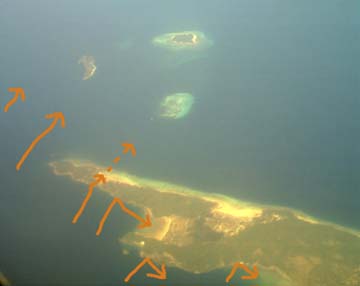

On February 1-7 , 2005 I went to the tsunami stricken regions of Thailand on a journalistic research and relief mission. Before scrolling down, be forewarned, some of the pictures are graphic and can be disturbing.
Here is the original email called "An Open Suitcase of Relief" that stated it all ...
IN THE TSUNAMI WAKE © 2005, Brad Olsen
The placid Khao Lak beach ... as seen on Feb. 4th,
2005 |
Another room in Katarina's hotel. Rescue workers had
already collected luggage and most of the victim's valuable items. |
One of many bathrooms I viewed with personal items
still intact. |
Our first view of Khao Lak. Most hotels were fenced
off and already gutted. |
 |
 |
 |
 |
|
Damage from the tsunami ... |
... was uniformly destructive. |
Everything in its path ... |
... suffered immeasurably. |
Swimming pools are now swamps. |
Rescue operations continue. |
Thai laborers do most of the heavy work. |
This boat is about one mile inland. |
Khao Lak may never be the same. |
The damaged buildings can be fixed ... |
... but the lives are lost forever. |
On Phuket Island forensic experts ID the thousands
of foreign tourists ... |
... The experts are almost all European police officers
who work on crime scenes. Bodies are being loaded in rear from freezer
to truck. |
The "Open Suitcase of Relief" weighed about
60 pounds ... |
... And was gladly delivered to the main hospital
closest to Khao Lak beach. |
A solitary flower memorial on Patong Beach. |
The good people at the PTA Recovery Center. |
Only the immediate beachfront property of Patong Beach
still bears tsunami scars ... |
... but the cleanup and rebuilding is progressing
every day. |
Wreckage of various items are still to be found ...
but not for long. |
Karen found this shirt in a destroyed Koh Pei Pei
shop. I'd hate to think who took it seriously enough to wear. |
A peaceful Buddhist monastery was transformed in a
day ... |
... to a makeshift morgue for thousands of bodies
and a relief center for survivors. |
The Yan Yao monastery is now the "Center for
Forensic and Identification" for the 1000s of Thai victims ... |
... as thousands of bodies await their identity in
refrigerated containers along the riverbank. |
Yet the monks of Yan Yao still seem blissfully at
ease. |
Bang Niang Camp. All of the people pictured here lost
one or several relations in the tsunami. |
To the left is our guide Don. Below is the pregnant
woman who guided us first to the man who lost seven family members, then
to the others. |
||||
 |
The "Laguna" suffered erosion damage, but
buffered many hotels by absorbing the waves. |
Bang Tao has several restaurants on the beach that
will likely never reopen again. |
The ubiquitous Spirit House reminds people that there
is hope ... |
... in troubled times. We are mere mortals after all,
or as a popular bumper sticker says: |
"We are not humans having a spiritual experience,
but spirits having a human experience." |
The outer Thai islands of Koh Pei Pei feature: |
hidden beaches amongst soaring cliffs ... |
Solitary towers of limestone jutting from the sea
... |
Some of the best SCUBA diving in SE Asia ... |
Fantastic boat tours of the islands, including the
location where they filmed The Beach. |
The flat beach areas were, unfortunately, in the direct
path of the tsunami. |
The exact moment clocks stopped ticking in Pei Pei
village -- 10:36 a.m. |
Children's toys scattered in the debris ... |
... not far from a kid's small bicycle. For me, this
area was the hardest to inspect. |
The smell of something rotting found itself
into our noses on several occasions. |
In this shot, I counted no less than six walls punctured
in a row from the force of the great wave. |
The lead coordinator of the Thai Tsunami Volunteers |
It is still hard for me to imagine lying in a 2nd
floor bedroom and having a huge wave come crashing through the wall. |
Despite coping with the harsh reality of tsunami destruction,
we still left with smiles ... |
... after all, Thailand is considered "The
Land of Smiling People" ... |
... and SW Thailand is one of the most beautiful places
on earth, with virtually no other tourists around during high season --
plus fantastic weather. |
On my flight back I caught a glimpse of Langkawi,
Malaysia -- the island were I attended the ATF conference. |
More Andaman Sea photos taken while flying from Phuket
to Kuala Lumpur. Apart from the first Langkawi shot, the rest are Thailand. |
 |
 |
 |
 |

"Let the world change you ...
and you can change the world."
-- from The Motorcycle Diaries
 |
 |
 |
 |
 |
 |